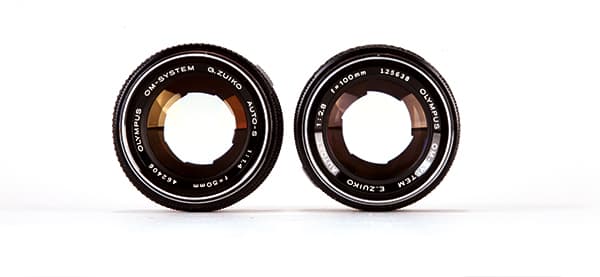
Digital cameras use a wide range of sensor sizes, with the full-frame sensor in the Nikon D810 (left) being four times the area of the Four Thirds sensor in the Olympus OM-D E-M5 II (right) and APS-C halfway in between
I’m pretty sure most photographers will have heard the phrase ‘f/8 and be there’. It’s long been considered a handy rule of thumb for getting the sharpest results from your lenses. Shoot at wider apertures and you risk getting softer images, due to blurring from lens aberrations and, perhaps, inadequate depth of field. Stop down further and your images will get progressively softer due to diffraction, and perhaps also suffer from camera shake if you try to handhold at too-slow shutter speeds. In general, when shooting 35mm film, f/8 often represents a happy medium between these various effects.
Equally, keen students of photography will likely be aware of the ‘Group f/64’ of photographers active in California in the 1930s, of whom Ansel Adams is perhaps the best-known member. As their name implies, they expounded stopping their lenses down to f/64 to get the sharpest, most detailed results. How can we reconcile these two apparently contradictory principles?
The answer lies in film formats. Adams and his associates were using large-format cameras that produced negatives of up to 10x8in. It turns out that due to the laws of optics, the larger the film format, the smaller the aperture required to achieve any given depth of field. But the flip side is that diffraction blurring has a weaker impact on image sharpness on larger formats, too. So while large-format photographers need to use small apertures like f/64 to gain sufficient front-to-back sharpness, they can get away with it without excessive blurring of their images, too.
In fact, when you do the calculations, the two effects go precisely hand in hand. If you double the dimensions of the film or image sensor, you have to double the f-number to get the same depth of field. At this point you’ll also get exactly the same degree of diffraction blurring, when looking at the image as a whole.
Of course, this is all very well, but you may be wondering what relevance it has today. Well, with the proliferation of different sensor sizes in digital cameras, it is more important than ever, as each has a different optimum aperture setting.
Sensor size and aperture selection
If you use cameras with different size sensors – perhaps a 1-inch sensor compact, a Micro Four Thirds mirrorless model and a full-frame DSLR – it’s important to understand how best to set the aperture on each. For this, I’m going to introduce an important concept of equivalent apertures. This is directly analogous to the familiar idea of equivalent focal lengths, which helps us to visualise the relationship between focal length, sensor size and angle of view. In a similar fashion, the idea of equivalent apertures helps us understand how to get the same depth of field and diffraction blurring on different sensor formats.
The basic principle here is that for any given angle of view, the depth of field and diffraction blurring is determined mostly by the size of the lens’s entrance pupil – i.e. the diameter of the aperture as seen from the front of the lens. This is what the f-number refers to. With a 200mm lens at f/8, for example, the entrance pupil is 200mm divided by 8, or 25mm.

This image shows how the size of the entrance pupil relates to the focal length and aperture. A 50mm lens set to f/2 (has the same size entrance pupil as a 100mm set to f/4
Let’s imagine that we want to replicate the pictorial effect of using a 200mm lens at f/8 on a full-frame camera, but with a camera that has a different sized sensor. For the sake of simplicity I’m going to use Micro Four Thirds as an example, because the ‘focal length multiplier’ or ‘crop factor’ is 2x, which makes the maths very easy. To get the same angle of view, we need to use a 100mm lens, and to get a 25mm entrance pupil, we need to set an aperture of 100mm divided by 25mm, which equals f/4. So, just as a 100mm lens on micro four thirds is equivalent to 200mm on full frame in terms of angle of view, f/4 on micro four thirds is equivalent to f/8 on full frame in terms of depth of field and diffraction blurring. From this it follows that, ideally, we should be setting the aperture to f/4, or thereabouts, on micro four thirds, most of the time.
Now at this point you might be wondering about those optical aberrations we were worried about earlier. Fortunately, it turns out that lenses designed to cover a smaller sensor size can usually be made with fewer aberrations at any given aperture.
It should be easy to see from this example that just as equivalent focal lengths are related by the sensors’ crop factors, so are equivalent apertures. It’s therefore simple to establish a set of apertures equivalent to f/8 on full frame for the most commonly used sensor sizes. For APS-C (1.5x crop) it’s f/5.6; for micro four thirds (2x crop) it’s f/4; and for 1in (2.7x crop) it’s f/3. Equally, if we consider f/16 to be the smallest aperture we’re happy to use on full frame before diffraction blurring becomes completely intolerable, we should limit ourselves to f/11 on APS-C, f/8 on Micro Four Thirds and f/6.3 on 1-inch sensor cameras.

Micro Four Thirds, 50mm f/2

Full frame, 100mm. f/4 As these two pictures illustrate, shooting at f/2 on a camera with a Four Thirds sensor gives broadly the same results as f/4 in full frame, in terms of both depth of field and the blurring of out-of-focus areas
Modern lenses are sharper
Another point is that modern lenses are better than those from 10 or 20 years ago. They’re much sharper and so can be used at larger apertures, while still giving sharp pictures. The shallow depth of field at larger apertures can still be a problem but the latest autofocus systems are more capable, while electronic live view permits accurate manual focusing.
Summary
If you buy a camera with a 1-inch or Four Thirds sensor, you’re best off using larger apertures than you might be used to with full frame, at least in terms of sharpness. Apply this principle and you’ll be well on the way to getting the best from your cameras.






